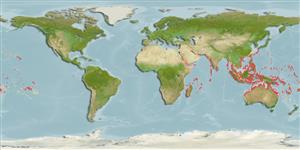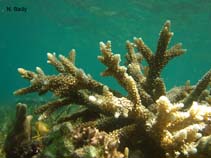Acropora formosa (Dana, 1846)
| Native range | All suitable habitat | Point map | Year 2050 |

|
| This map was computer-generated and has not yet been reviewed. |
| Acropora formosa AquaMaps Data sources: GBIF OBIS |
Classification / Names Common names | Synonyms | CoL | ITIS | WoRMS
Anthozoa | Scleractinia | Acroporidae
Environment: milieu / climate zone / depth range / distribution range Ecology
Reef-associated; depth range 0 - 25 m (Ref. 8294). Tropical; 30°N - 34°S, 27°E - 135°W (Ref. 846)
Distribution Countries | FAO areas | Ecosystems | Occurrences | Introductions
Indo-Pacific. Tropical and subtropical.
Length at first maturity / Size / Weight / Age
Maturity: Lm ? range ? - ? cm Max length : 49.0 cm COLD male/unsexed; (Ref. 269); common length : 49.0 cm male/unsexed; (Ref. 269)
Short description Morphology
This is the classic "staghorn coral", with aborescent growth form and branches usually less than 50 cm in length. Colonies are composed of smooth appearing, straight branches less than 2 cm thick; branching is irregular such that colonies from thickets which often dominate large areas of lagoon in shallow and intermediate depths (Ref. 269).
Depth based from occurrence record (Ref. 8294); to be replaced with a better reference. Dominates large areas of lagoon in shallow and intermediate depths (Ref. 269). Has high bleaching level and high estimated mortality in Palau (Ref. 66144).
Life cycle and mating behavior Maturity | Reproduction | Spawning | Eggs | Fecundity | Larvae
Hermaphroditic (Ref. 113712). Mature gametes are shed into the coelenteron and spawned through the mouth. Life cycle: The zygote develops into a planktonic planula larva. Metamorphosis begins with early morphogenesis of tentacles, septa and pharynx before larval settlement on the aboral end (Ref. 833).
Main reference
References | Coordinator | Collaborators
Hodgson, G. 1998. (Ref. 269)
IUCN Red List Status (Ref. 130435)
Near Threatened (NT) ; Date assessed: 03 January 2008
CITES status (Ref. 108899)
Appendix II: International trade monitored
CMS (Ref. 116361)
Not Evaluated
Threat to humans
Human uses
| FishSource |
Tools
More information
Internet sources
BHL | BOLD Systems | CISTI | DiscoverLife | FAO(Publication : search) | Fishipedia | GenBank (genome, nucleotide) | GloBI | Gomexsi | Google Books | Google Scholar | Google | PubMed | Hexacorallians of the World | Tree of Life | Wikipedia (Go, Search) | Zoological Record
Estimates based on models
Preferred temperature
(Ref. 115969): 24.8 - 29.3, mean 28.4 (based on 3503 cells).
Price category
(Ref. 80766):
Unknown.



